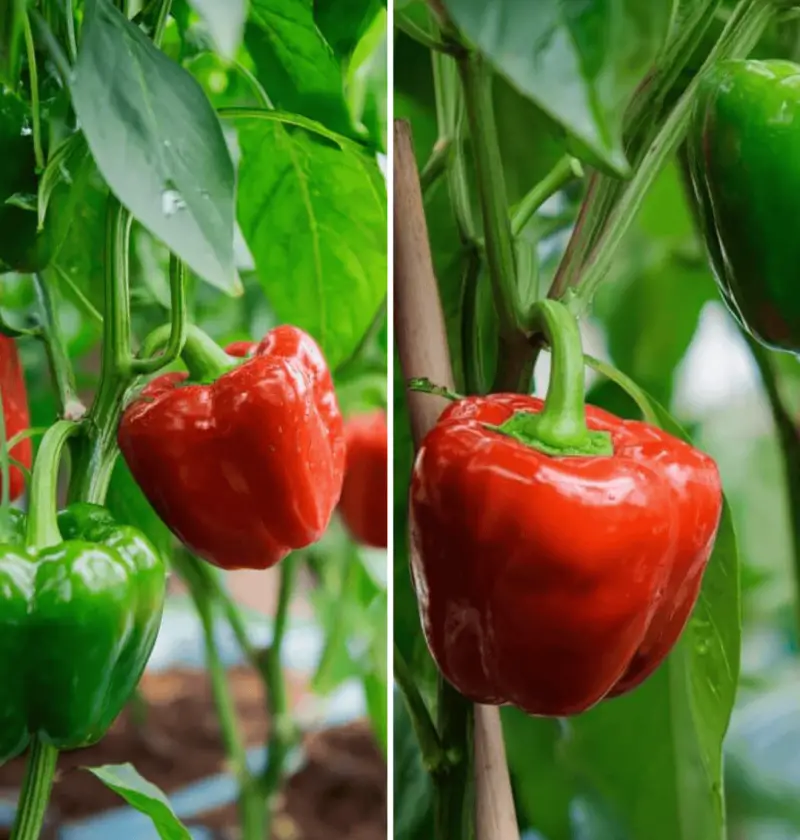Save This Recipe
There’s something heartbreakingly quiet about walking into your garden and noticing your plants aren’t quite themselves. A couple of summers ago, I found myself standing over my tomato beds with a cup of coffee in one hand, staring at yellowing leaves and thinking, “What on earth went wrong?”
You know that moment — when the plants you’ve tended to like children start looking a little… sad. Maybe it’s cucumbers with stunted growth, tomatoes with curled leaves, or peppers refusing to fruit. Been there. I’ve sat on the back porch, dirt under my nails, wondering if it was all a lost cause.
But here’s the beautiful part — it’s almost never too late. With a few pantry items and a little patience, I’ve brought my babies back from the brink. Let me share the hacks that turned my wilting garden into a bounty of crisp cukes, juicy tomatoes, and fiery little peppers.
Why You’ll Love These Garden Hacks
-
Budget-friendly – Most use things you already have in your kitchen.
-
Gentle but effective – No harsh chemicals or complicated regimens.
-
Time-tested by home gardeners – Including yours truly!
-
Improves plant health AND soil structure – a two-for-one win.
-
Naturally boosts fruit production – because that’s what we’re here for, right?
Start Here: Why Are My Plants Weak?
Let’s not skip this — because throwing coffee grounds at a problem won’t fix a watering issue (trust me, I’ve tried).
Weakness in cucumbers, tomatoes, and peppers usually boils down to:
-
Nutrient deficiencies (missing N-P-K or calcium, for example)
-
Poor watering habits (either too much or not enough)
-
Pests or disease (aphids, fungal problems, you name it)
The fix? Treat the cause, not just the symptoms. Keep an eye out for yellowing leaves, pale veins, wilting even with water, or blossom-end rot. Then tackle it smart.
1. Epsom Salt: Your Cucumber’s Best Friend
If your cucumber leaves are turning yellow between the veins, they might be begging for magnesium. Epsom salt is my go-to.
What to do:
Mix 1 tablespoon of Epsom salt in 1 gallon of water. Water around the base of your cucumber plants every two weeks. They’ll perk up like you just gave them a green smoothie.
Tip: Don’t pour directly on leaves — it’s better absorbed by the roots.
2. Coffee Grounds: Tomato Growth on a Budget
I drink coffee like it’s my job, so I always have grounds on hand — and guess what? So do my tomatoes.
What to do:
Sprinkle a thin layer around the base or mix it into the top inch of soil. It adds nitrogen, improves soil texture, and worms love it. But don’t overdo it or you’ll get all leaves, no fruit.
Fun fact: Tomatoes and coffee are both acid-lovers. Match made in compost heaven!
3. Crushed Eggshells: Goodbye, Blossom-End Rot
Peppers (and tomatoes too!) need calcium to prevent those ugly black-bottom fruits. Enter: the humble eggshell.
What to do:
Rinse, crush, and sprinkle around the base of the plant. Or, soak shells in water for 3 days, then water your peppers with it weekly.
Speedy trick: Blend your eggshells for faster absorption.
4. Banana Peel Tea: Potassium Punch
Don’t toss those peels! They’re little yellow powerhouses full of potassium.
What to do:
Chop and bury peels in the soil or soak them in water 2–3 days. Use that “banana tea” to water around tomato and pepper plants biweekly.
Bonus: Also adds phosphorus and calcium. Who knew?
5. Compost Tea: A Gentle Elixir
Think of this as bone broth for your garden.
How to make:
Soak a shovelful of compost in a 5-gallon bucket of water (use a mesh bag or old pillowcase). Let it sit 24–48 hours, stirring occasionally.
How to use:
Dilute 1:10 with water and pour around your plants every couple weeks.
Helpful aside: Don’t let it sit too long or it’ll get smelly.
6. Liquid Seaweed: Plant Vitamins in a Bottle
If you have a nursery nearby, check for liquid seaweed. It’s packed with micronutrients that help your plants bounce back like spring chickens.
What to do:
Mix 1 tablespoon per gallon of water and spray the leaves or water the base every two weeks.
Heads up: It smells like the beach. A funky one.
7. Fish Emulsion: Not Cute, But Oh So Effective
This one’s a little… aromatic. But your plants will thank you.
What to do:
Dilute 1 tablespoon in 1 gallon of water (check your label!) and apply to the soil every 3–4 weeks. Great for overall growth and especially good early in the season.
Real talk: Store it in a sealed container far from your kitchen.
8. Molasses Magic
This sweet trick feeds the beneficial microbes in your soil, helping with nutrient uptake and fruit sweetness.
What to do:
Mix 1 tablespoon of unsulfured blackstrap molasses with a gallon of water. Water once a month.
Pro tip: Combine with compost tea for a microbial party underground.
9. Companion Planting: A Garden Friendship Circle
Some plants just get along better. A little matchmaking goes a long way.
-
Tomatoes + basil = flavor boost and insect repellent
-
Peppers + marigolds = pest defense
-
Cucumbers + nasturtiums = beetle bouncer
Note: Keep fennel far, far away. It’s a lone wolf.
10. Watering: Not Too Much, Not Too Little
Here’s the golden rule: deep and infrequent beats daily sprinkles.
-
Cucumbers: Like moisture — water 1–2x/week depending on heat
-
Tomatoes/Peppers: Prefer deep, occasional watering to build roots
Helpful nudge: Water in the morning to avoid mildew. And always at the base!
A Note on Substitutions & Swaps
-
No coffee? Use alfalfa meal or blood meal.
-
No eggshells? Garden lime does the trick.
-
No banana peels? Wood ash adds potassium too (sparingly).
Don’t stress — the idea here is to work with what you’ve got.
How to Store & Reuse These Natural Boosters
-
Coffee grounds: Dry them out and store in a jar — they can mold if left wet.
-
Banana peel tea: Keep refrigerated up to a week.
-
Compost tea: Use within 48 hours.
-
Molasses mix: Make fresh each time (it gets sticky and weird fast).
One Last Thought from My Porch Swing
If your garden feels like it’s struggling, don’t give up. Plants are more forgiving than we think. With a little TLC and some kitchen magic, those droopy leaves can perk up again.
I’d love to hear what’s worked in your garden — or if you’ve tried any of these tricks! Drop a comment below or send me a photo of your pepper babies. Let’s grow something beautiful, together.
Happy gardening,

